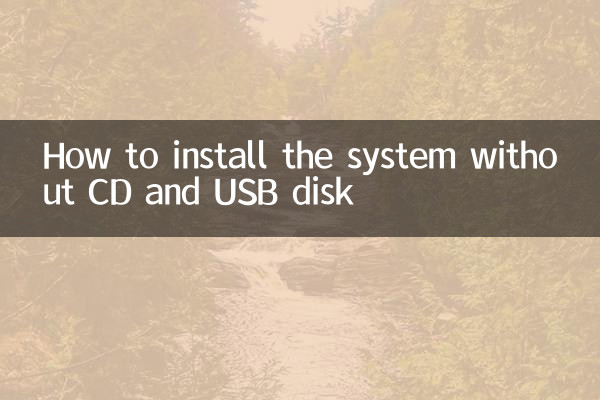How to install the system without a CD or USB flash drive
In modern computer use, installing an operating system is a common requirement. However, many users may be confused if there is no CD or USB flash drive. This article will introduce in detail several methods to install the system without a CD or USB flash drive, and attach the hot topics and hot content on the Internet in the past 10 days to help readers better understand the current technology trends.
1. Hot topics and hot content (last 10 days)

| hot topics | heat index | Related platforms |
|---|---|---|
| Windows 11 23H2 update | 95 | Weibo, Zhihu, Bilibili |
| Cloud installation system technology | 88 | CSDN, Jianshu, Twitter |
| Recommended Linux distributions | 82 | Reddit, GitHub, Zhihu |
| Virtual machine installation system | 75 | YouTube, Stack Overflow |
2. How to install the system without CD or USB disk
1. Use network installation (Netboot)
Network installation is a way to directly download and install the system through a local area network or the Internet. Many Linux distributions (such as Ubuntu, Debian) support network installation, and Windows can also achieve it through PXE (Preboot Execution Environment).
Steps:
1) Enter BIOS settings and enable network boot (PXE).
2) Select the network installation source, wait for the system to download and start the installation program.
3) Follow the prompts to complete the installation.
2. Install the system using a virtual machine
If the host already has an operating system, you can directly load the ISO image file through virtual machine software (such as VMware, VirtualBox) to install the system.
Steps:
1) Download and install the virtual machine software.
2) Create a new virtual machine and select the ISO image file as the installation source.
3) Start the virtual machine and complete the system installation.
3. Install the system using cloud services
Some cloud service providers (such as Azure, AWS) support directly creating virtual machines and installing systems without local media.
Steps:
1) Register a cloud service account and log in.
2) Create a new virtual machine instance and select the required operating system image.
3) Start the instance and connect remotely to complete the configuration.
4. Install through hard disk partition
If you already have a system image file, you can unzip it to another partition of your hard disk and install it directly by modifying the startup items.
Steps:
1) Extract the ISO image file to a non-system partition.
2) Use tools (such as EasyBCD) to add startup items.
3) Restart the computer and select the new startup item to complete the installation.
3. Precautions
1)Back up data:Be sure to back up important data before installing the system to avoid loss.
2)Network stability: Network installation relies on a stable network connection, and it is recommended to use a wired network.
3)Compatibility: Make sure the chosen method is compatible with the hardware, especially older devices.
4. Summary
There are still many ways to install the operating system without a CD or USB flash drive. Whether it is through network installation, virtual machine, cloud service or hard disk partition, users can choose the most suitable solution according to their own needs. As technology develops, future installation methods may become more convenient.

check the details

check the details